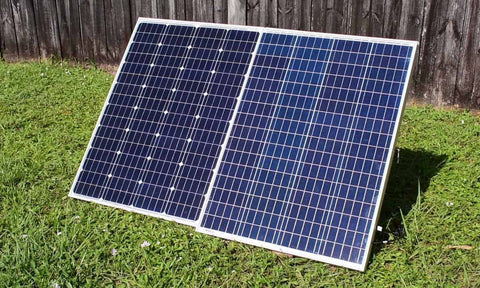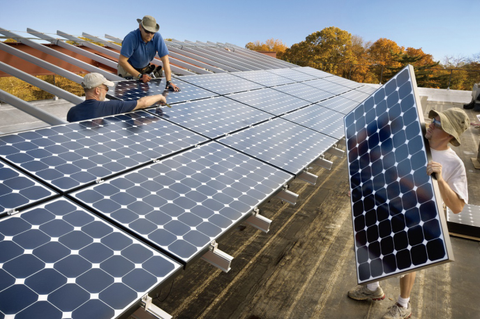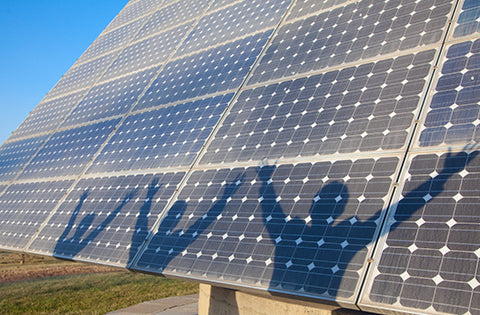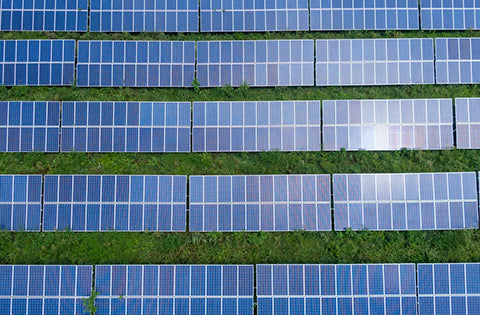At present, the mainstream solar panels in the market are divided into monocrystalline solar panels, polycrystalline solar panels and thin-film solar panels. The differences among the three are:
The photoelectric conversion efficiency of monocrystalline silicon solar cells is about 18%, and the highest is 24%, which is the highest among all kinds of solar cells. However, the production cost is very high. Because monocrystalline silicon is generally packaged with tempered glass and waterproof resin, it is firm and durable, and its service life can reach 25 years.
2: Polycrystalline solar panel
The manufacturing process of polycrystalline silicon solar cells is similar to that of monocrystalline silicon solar cells, but the photoelectric conversion efficiency of polycrystalline silicon solar cells is much lower, and its photoelectric conversion efficiency is about 16%. In terms of production cost, it is cheaper than monocrystalline silicon solar cells. It is easy to manufacture materials, saves power consumption, and has a low total production cost. Therefore, it has been greatly developed. In terms of performance price ratio, monocrystalline silicon solar cells are slightly better.

Amorphous silicon solar cell is a new type of thin-film solar cell that appeared in 1976. It is completely different from the manufacturing method of monocrystalline silicon and polycrystalline silicon solar cells. The process is greatly simplified, the consumption of silicon materials is small, and the power consumption is lower. Its main advantage is that it can generate electricity under weak light conditions. However, the main problem of amorphous silicon solar cells is that the photoelectric conversion efficiency is low. The international advanced level is about 10%, and it is not stable enough. With the extension of time, the conversion efficiency declines.
In addition, different types of solar panels have different components:
1: Monocrystalinel solar panel
The components of monocrystalline battery panel are the same, except that its battery sheet is made of monocrystalline silicon. The advantage of monocrystalline silicon is that its conversion rate is higher than that of polycrystalline silicon. Under the same area, it can generate more electricity! Reduced land rent and support costs. It is slightly better than polysilicon in performance, but higher than polysilicon in manufacturing cost. So the price of single crystal battery panel is higher than that of polycrystalline silicon battery panel!
2: Polycrystalline solar panel
The composition and structure of the polycrystalline battery panel are exactly the same as that of the single crystal, except that the battery sheet is made of polycrystalline silicon. After the introduction of polycrystalline battery board, because of its low price, and its performance is not very different from that of single crystal! The market has been very popular. Moreover, due to the continuous innovation of technology in recent years, the gap between polycrystalline silicon panels and polycrystalline cells in performance and conversion rate is not very large, which can be almost ignored. But there is a big difference in price. Therefore, polysilicon is more popular in the market.

3: Thin film battery board
The price of thin-film battery panel is higher than that of silicon crystal battery panel. And the conversion rate has no advantage, but its influence on weak light effect and sun shading is better than that of monocrystalline and polycrystalline battery panels! It is suitable for areas with poor geographical location and perennial shadow.
Therefore, both monocrystalline silicon and polycrystalline silicon panels have their own advantages and disadvantages. SOLARPARTS has been committed to the R & D and manufacturing of crystalline silicon solar panels. Our products are favored by international consumers. If you are interested in solar panels, please contact us immediately through the following ways:
Phone: +86-13923729619 Fax: +86-755-28720791
WhatsApp: +86-13923729619 Wechat: 13510027129
Email address: Philip@isolarparts.com
Homepage: www.isolarparts.com



